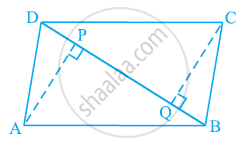Advertisements
Advertisements
प्रश्न
Diagonals of a rectangle are equal and perpendicular. Is this statement true? Give reason for your answer.
पर्याय
True
False
उत्तर
This statement is False.
Explanation:
Diagonals of a rectangle are equal but need not be perpendicular.
APPEARS IN
संबंधित प्रश्न
ABCD is a parallelogram and AP and CQ are perpendiculars from vertices A and C on diagonal BD (See the given figure). Show that
- ΔAPB ≅ ΔCQD
- AP = CQ

ABCD is a rectangle with ∠ABD = 40°. Determine ∠DBC .
State, 'true' or 'false'
If two adjacent sides of a parallelogram are equal, it is a rhombus.
In the figure, given below, AM bisects angle A and DM bisects angle D of parallelogram ABCD. Prove that: ∠AMD = 90°.

In the given figure ABCD is a rhombus with angle A = 67°

If DEC is an equilateral triangle, calculate:
- ∠CBE
- ∠DBE
Find the area of a parallelogram whose base is 12cm and the height is 5cm.
Two adjacent sides of a parallelogram are 20cm and 18cm. If the distance between the larger sides is 9cm, find the area of the parallelogram. Also, find the distance between the shorter sides.
Find the perimeter and area of a rectangle whose length and breadth are 12cm and 9cm respectively.
The diagonals of a square are perpendicular to one another.
Give reasons for the following :
A square can be thought of as a special rhombus.
